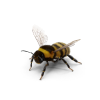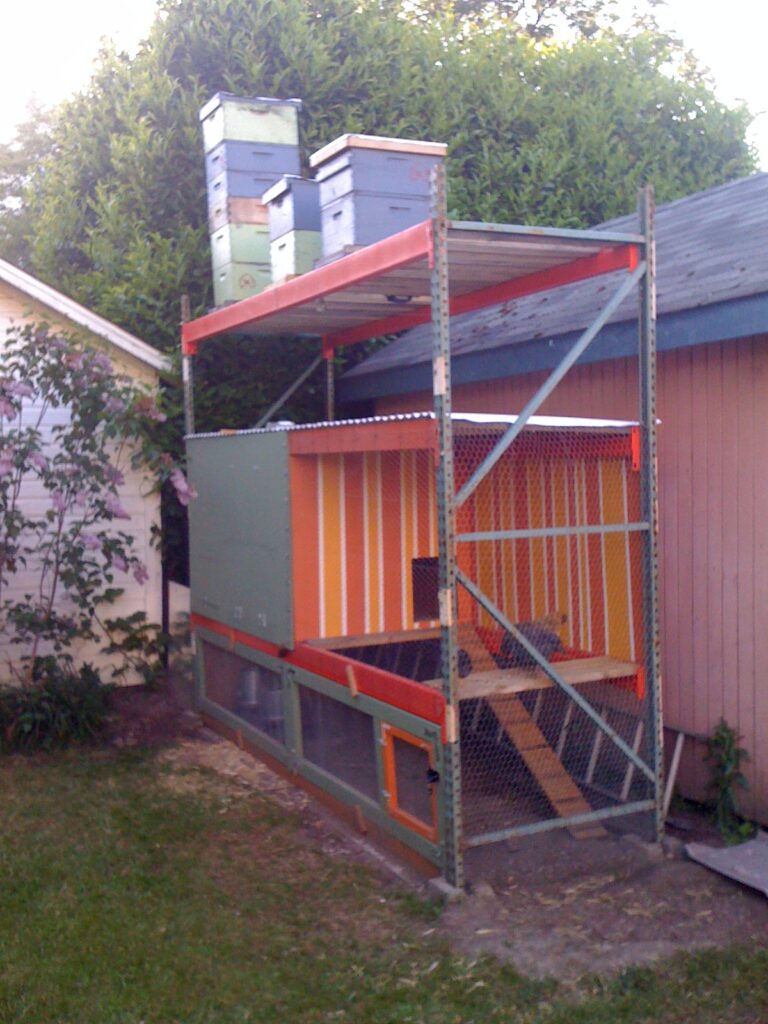Well, this will be one of the last posts of the season, and we shall exit with a bang. The air is getting nippy, the flowers folding their petals, so it’s time to remove the honey supers for extraction and tighten up the hives for winter.
When I headed out on Saturday, I expected to have to find Hive 1 thriving, Hive 2 weak but functional. I expected to have to remove the honey supers, then remove each from from each of the boxes and shake all the bees off of it, so I could have bee-less comb to extract (the girls would only return to the main hive after I shook them off). I expected to see some chilly but hearty bees coming and going.
What I found was a riot, looting, and a two hives of bees making a last, brave stand against an onslaught of yellowjackets.
 Yellowjackets are not bees. Let me be perfectly clear about this. Yes, they are yellow and black striped, much like bees. Yes, they are flying insects. Yes, like bees, they sting. But no, they are not bees.
Yellowjackets are not bees. Let me be perfectly clear about this. Yes, they are yellow and black striped, much like bees. Yes, they are flying insects. Yes, like bees, they sting. But no, they are not bees.
Bees are softly furred, industrious, communal workers who look after one another and build colonies that last years upon years. Bees collect nectar and pollen from flowers and store it away to eat and to feed to their young during the long winter months. Bees will sting in self-defense, but, because they leave their stinger behind, they die when they sting and are thus careful about their use of their terrible weapon.
Yellowjackets are nasty, mean-spirited wasps who build their nests from wood-pulp, not wax. Each colony starts the year anew from a single queen, with no sense of contact or history of their previous generations. They eat bugs and other meat that they can lay their greedy little mandibles on, hovering around garbage cans and other foul refuse. They can sting again and again, and do so with malice and relish.
And these yellowjackets, not content to hover menancingly about my backdeck dinners, not content to buzz around the soda-sticky fingers of innocent children, these despicable vermin were assaulting my hives in force, buzzing in and out of the home that my bees had so painstakingly and lovingly built, dashing in past the desperate defenders, gorging and feasting on the winter supplies they found therein, then waltzing, fat and bloated, back out to beat their wives or vote Republican or do whatever it is they do for entertainment.
The horror!
OK, so I got to work. First, I removed the honey supers. I was very pleased to find that they were almost completely abandoned already in both hives, the girls having moved down into the brood chambers (the bottom two boxes that we leave for the girls to overwinter in). There were hefty food supplies in the brood chambers, so they should have no want of food for my harvest.
Unfortunately, while Hive 1 still had lots of eggs, it appears that Hive 2 is still either without a queen, or stuck with a virgin queen, for the only brood I saw were drones. As you may remember from previous posts, only queen bees can lay worker (female) bee eggs. The worker bees, if they are queenless, can lay eggs, but only drones (males), who don’t do any work and can’t lay any kind of eggs. Given this, the population without a laying queen will eventually dwindle to nothing.
This was a bit puzzling to me, as I had clearly seen a hatched queen cell when I was in Hive 2 in July, but who knows…maybe the mating season was over, maybe she died, maybe she’s gay.
In any case, I removed the honey supers (which will also reduce the size of the area they need to keep warm over winter) and added entrance reducers, pieces of 1″ x 1″ wood that sits across their front door and makes it smaller and thus less windy and, more importantly to the immediate situation, easier to defend.
Ah, it was awesome to watch the tides turn on Hive 1. The girls of Hive 1 practically linked arms and set about driving back the invading yellowjackets. The beastly wasps would zoom in and immediately a burly bitch of a bee would march out to him. In most cases, a quick shove from one of the girls was enough to send the foul scavenger packing, but in a few cases, it took a bit more to get the message across: this place is closed. On a few occasions in the half hour or so I watched, I saw three bees jump on top of one of these heartless invaders and put the wasp into a little bee-sized kick circle, the three of them piled on top in a buzzing mass. They’d almost immediately tumble off the front stoop to the ground below, where I’d lose sight of them, only the death cries of overwhelmed yellowjacket audible.
Hive 2 was not faring quite as well. The girls there were heartned by the reduced entrance, but were still outgunned by the neverending onslaught of yellowjackets. I tipped my ear in close and could practically here the flustered and overwhelmed bouncer bees trying to hold down the fort: “Ummm..excuse me…you can’t go in there, it’s closed…aaah, no, excuse me, please don’t go in there or…shit…OK, he can go in, but it’s closed now, you gotta…oh, OK, I guess you’re with your friend there, umm, OK I guess, but that’s the last one…OOF! Seriously guys, I’m gonna have to call the manager if…hey, stop that, you can’t eat that, we’re saving it for…oh, ah, OK but that’s the last one.” Poor girls. I doubt they’ll make it through the winter.
I shot a bit of video of the yellowjackets trying to infiltrate. The first scenes are of the yellowjackets being repulsed from Hive 1. The second set of scenes is the yellowjackets attacking Hive 2 a bit more successfully (watch for one the sneaky sons of bitches sneaking in). The last scene is one of the only full on yellowjacket vs. bee tussles I caught on film. Links to my film below, but really, if you want to see some killer hornet vs. bee action, watch this incredible National Geographic movie. Warning: contains scenes of graphic insect on insect violence.






